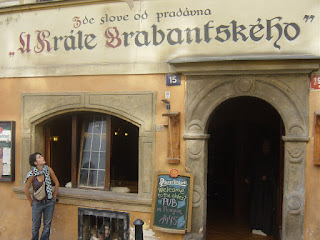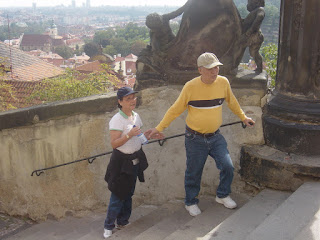Above: Old Town Hall Astronomical Clock ~ installed in 1410, it remains one of the oldest functioning astronomical clocks in the world. Though restored after WWII, its original mechanism still tracks the position of the sun and moon, zodiac signs, and Old Czech time.
Above: The Baroque St. Nicholas Church at Old Town Square, completed in 1737, originally belonged to the Catholic Church before passing to the Orthodox Church and later the Czechoslovak Hussite Church, which was founded here in 1920. The striking chandelier, a gift from Russian Tsar Alexander II in 1880, adds to the church’s grandeur.
Above left: Our guides for the day; Above right: St. Nicholas Church in Old Town (Staré Město)
Above left: The Church of Our Lady before Týn, a Gothic masterpiece, distinguished by its striking twin spires.
Above: Historic house signs in Old Town - used before house numbers became standard - reflect professions, noble emblems, and symbolic meanings tied to the buildings they mark. Prague is home to around 265 of these unique signs, preserving a rich architectural tradition.
Above left: The building’s facade features decorative frescoes, blending its rich historical roots with the vibrancy of modern-day businesses.
Above: The Basilica of St. James the Greater has a richly decorated Baroque interior
Above right: The organ inside The Basilica of St. James the Greater
Above left: The Franz Kafka statue by Jaroslav Rona, inspired by Kafka's short story: 'Description of a Struggle'. Franz Kafka (1883-1924) was a German-language writer from Prague, known for his exploration of absurdity, paranoia, existential dread, and oppressive systems. His legacy gave rise to the term "Kafkaesque," which describes situations that are bizarre, unjust, and eerily disorienting.
Above right: Spanish Synagogue in Prague's Jewish Quarter
Above left: The Old Synagogue Restaurant
Above right: The Old-New Synagogue (Altneuschul)
Above right: Old Town Bridge Tower
Above: On Charles Bridge
Above: The Vltava River
Above: The wall markings indicate significant flood years (1390, 1784, 1945, and 2002) showing how the water levels varied across centuries. The most recent inscription, from August 2002, refers to "hladina vody," meaning "water level" in Czech, commemorating the devastating flood that impacted much of Central Europe that year.
Above left: A historical water wheel
Above left: The John Lennon Wall ~ it became a symbol of freedom and resistance during the communist era in Czechoslovakia. After John Lennon's assassination in 1980, young Czechs, inspired by his music and ideals, began painting his portrait and writing lyrics on the wall; the wall remains a living monument to creativity and freedom
Above right: the rear façade of St. Nicholas Church in Lesser Town (Malá Strana)
Above left: Archbishop's Palace; Above right: Entrance to the Prague Castle ~ the grand gate is flanked by the Fighting Giants statues
Above left: St. George’s Basilica, founded in 920, is the oldest surviving church within Prague Castle. Its striking red and white facade and Romanesque architecture reflect centuries of history and restoration
Above right: St. Vitus Cathedral with its Gothic architecture - sharp spires, intricate stone carvings, and grand stained glass windows. It’s the largest and most significant church in the Czech Republic, deeply tied to the history of Bohemian kings and saints.
Above left: Lunch for 3 was 465 Czech koruna (about €20)
Above left: A second attempt at Chinese on our second night (€12)


















































































































































No comments:
Post a Comment